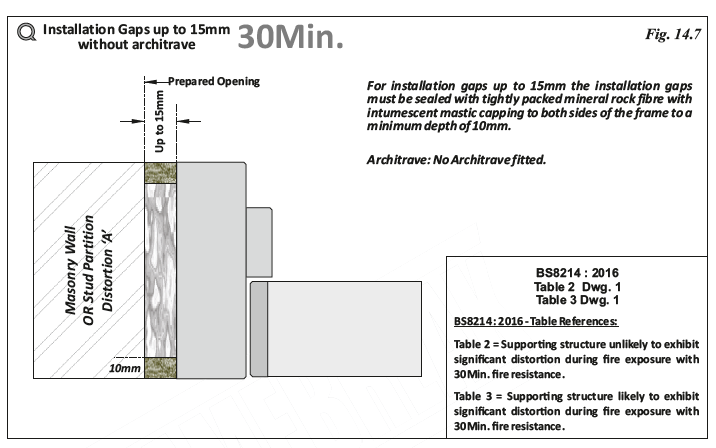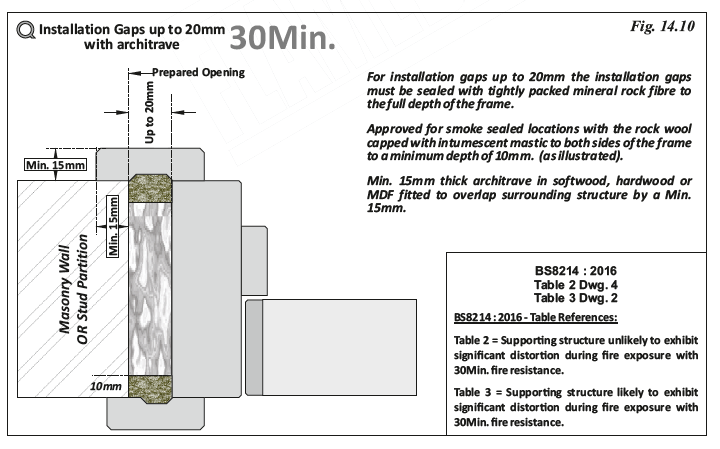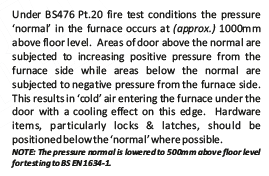-
Posts
427 -
Joined
-
Last visited
Everything posted by Neil ashdown
-
The guidance you need as follows: BS 8214: 2016 https://shop.bsigroup.com/ProductDetail/?pid=000000000030332501 IFSA https://www.ifsa.org.uk/documents Unless the brush seals are offset, there shouldn't be room for two brush seals as the gap between the edge of the door leaf and the frame should generally be 4mm max and 2mm min. Same for the gap at the meeting edges of double leaf doors. Be careful to ensure that the brush seals do not prevent the doors from self-closing completely. In the door closed position, the brush (or blade) should only lightly contact the surface that it sweeps.
-
If the seal is making a noise when the door opens, it is most likely from the brush or fin that provides restricted smoke spread protection. This type of seal needs to make light contact with the opposing surface in the door closed position so the noise is most likely due to friction. If the noise is a problem you could change the seals (all of them) for fire only seals (below) used in conjunction with the type of smoke/acoustic seal (bottom).
-

space between fire door frame and opening
Neil ashdown replied to a topic in Fire Doors and Accessories
Refer to BS 8214:2016 Timber-based fire door assemblies - Code of practice for details about how to seal the gap. -
Is it a new door? Do you have the name of the manufacturer (is there a label on the top edge of the door)?
-
Possibly repairable depending on extent of damage and of course, so long as the core of the door is not damaged.
-
Follow guidance BS 8214:2016 Timber-based fire door assemblies - Code of practice https://shop.bsigroup.com/ProductDetail/?pid=000000000030332501 with regard to specification of door assembly components.
-

Are fire doors needed in 4 storey 1920s house?
Neil ashdown replied to OliverJ's topic in Fire Doors and Accessories
Best to check with local authority building control on fire door requirements then. Protected escape route from upper floors, Approved document B (dwellings) Annex C Fire Doors. -

Are fire doors needed in 4 storey 1920s house?
Neil ashdown replied to OliverJ's topic in Fire Doors and Accessories
Does the work you are doing fall within the scope of Building Regulations? -

space between fire door frame and opening
Neil ashdown replied to a topic in Fire Doors and Accessories
Yes, timber packers should be used at all fixing points so that you can get a secure fixing. They can be full width of the door frame. Ensure the mineral wool is tightly packed to fill all gaps and leave no voids then cap the wool on both sides with a 10mm depth of intumescent mastic. -

Is an oak threshold permitted under a fire door?
Neil ashdown replied to a topic in Fire Doors and Accessories
Yes, Oak is a good timber for a fire door threshold. -
The regulations in terms of access and use of buildings is https://www.planningportal.co.uk/info/200135/approved_documents/80/part_m_-_access_to_and_use_of_buildings I would advise you to check with local authority building control as to whether your proposal is in scope of Part M requirements for dwelling houses. There are limits to how narrow a fire door leaf can be in terms of its fire resistance performance but as you haven't said how narrow the door would be, I cannot comment further.
-

Do I need to use special paint on new fire doors?
Neil ashdown replied to a topic in Fire Doors and Accessories
Assuming the fire doors are wooden ones. Strip and paint them as you would any wooden door. Do not paint over smoke seals and avoid adding metallic facings. -
This one is interesting because when timber-based doors are tested for fire resistance performance it is assumed that the door would be positioned at floor level. In fact the fire tests used in the UK are BS476 part 22 & EN1634-1 and both tests place a pressure at a certain height on the door from the furnace side, see below. However, the tests are a 'benchmark' and, as your scenario demonstrates, not always reflective of the use of the door in real life. Therefore it should be borne in mind that the fire resistance of the door in your end use may be different to its 'as tested' performance. Furthermore, the fire in a real life situation may be different in its character to the one in the BS/EN test furnace. Where you have any concerns, it would be best to discuss them with an expert in fire doors.
-
-
Government guidance can be found here https://www.gov.uk/government/publications/building-safety-advice-for-building-owners-including-fire-doors at page 29 and annexe A
-
Usually a flat entrance door that opens onto an outside area would not need to be fire resisting. However, there are some occasions where one would be necessary, such an example could be that there is a balcony / escape route above or adjacent to your door. If in doubt check with an expert.
-
To be certain you will need to check with the fire door manufacturer. The door could be composite construction or it could be solid timber? The knocker could be faced-fixed or it could be bolt through?
-
BS 8214:2016 Timber based fire door assemblies- Code of practice. Paragraph 9.5.2 deals with operating gaps "A typical gap to achieve good fire performance is between 2mm and 4mm".
-
A fire door must self-close all the way to the rebate stop. Contact an independent fire door inspector for advice. Fire door inspectors are listed at: https://fdis.co.uk/find-an-inspector-2/ and https://www.blueskycert.com/members-main/#fire
-
It would be advisable to consult a certificated fire door inspector to undertake on-site inspections to assess the suitability and condition of the existing fire doors. They should issue a full report detailing the doors and describing any necessary remedial actions. Avoid inspectors that do not provide sufficiently detailed reports. Much better to get a report that provides a full description of the work necessary to achieve compliance. Fire door inspectors are listed at: https://fdis.co.uk/find-an-inspector-2/ and https://www.blueskycert.com/members-main/#fire
-
It would be advisable to consult a certificated fire door inspector to undertake on-site inspections to assess the suitability and condition of the existing fire doors. They should issue a full report detailing the doors and describing any necessary remedial actions. Avoid inspectors that do not provide sufficiently detailed reports. Much better to get a report that provides a full description of the work necessary to achieve compliance. Fire door inspectors are listed at: https://fdis.co.uk/find-an-inspector-2/ and https://www.blueskycert.com/members-main/#fire
-
When repairing fire doors, fitting a hardwood lipping can be an effective method to repair a damaged edge or to achieve compliant door leaf to door frame gaps. However, it is likely that such repairs would affect the manufacturer's certification for the fire door. Can the manufacturer be identified so as to try and retain fire resistance performance certification, or is the manufacturer unknown? If unknown, can the door's fire rating be confirmed? Important considerations include: use of suitable adhesives, timber density and dimensions and of course the quality of the work. It would be advisable to undertake suitable fire door training and/or consult a specialist when undertaking these types of repairs.
-
From what you say it seems that the door is a flat entrance door. In which case the door should resist fire spread for at least 30 minutes and also restrict the spread of cold smoke. The Standard for installation of timber-based fire doors is 'BS 8214:2016 Timber-based fire door assemblies - Code of practice'. The Standard states that the gap between the bottom edge of the door leaf and the floor, in the door-closed position, should be 3mm. To resolve an issue where the gap is too large, the most effective method is to fit a threshold plate to the floor.
-
The fire risk assessment for the school should be clear about where fire doors are necessary. It would be expected that a school built to regulations in 1999 would have fire doors installed at the fire safety critical locations. Looking at risk from fire at the school, does the classroom need to be a fire compartment?
-

Have my doors been clad to fire-proof them?
Neil ashdown replied to HazelR's topic in Fire Doors and Accessories
Doors are sometimes clad with fire rated boards to improve fire resistance performance. However where fire resistance is required, the board used would usually be cement based rather than timber based.









